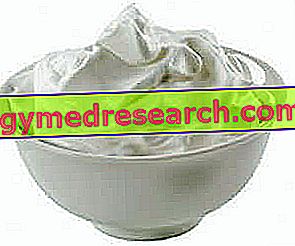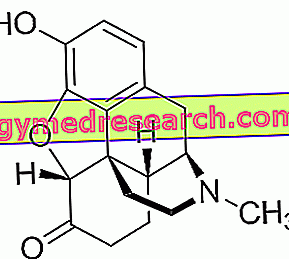Generality and production
The whipped cream is a foamy and soft mass, relatively stable, obtained by mechanical stirring of the liquid cream.

To obtain a good whipped cream, the operator's manual skills and / or the calibration of the instrument (depending on the type of processing) are also fundamental.
Types of cream
Not all cream is suitable for the production of whipped cream
There are 3 types of cream on the market, but only from one of these can you get whipped cream.
We immediately exclude the cream from the kitchen; it has a fat content that ranges from 20 to 25%, NOT MOUNT (later we will understand why) and has a semi-solid appearance, consequently to the formation of the casein gel that traps the fat globules. Sometimes, after a few months of storage, we notice a certain separation of the solid part from the liquid part which is reintegrated by mixing the compound.
Even the coffee cream is not able to froth; it has a lipid content too similar to milk, therefore insufficient (generally around 12%), and if it has undergone UHT treatment it is very stable and can be stored for a long time.
Finally we come to the whipping cream, that is the only one from which it is possible to obtain whipped cream. This has a fat intake that averages 35%, or the amount needed to make it reach up to 300% of the initial volume. If similar products are found but with lower lipid percentages (<30%), they will be decidedly less stable; on the contrary, with high doses of fat (up to 47%), these will be particularly difficult to assemble.
Limiting factors of production
If the process is not carried out in a technically unexceptionable manner (wrong time, speed, type of whisk etc.), it significantly increases the risk of obtaining the OPPOSITE foaming effect, that is to say the butter making . In summary, by excessively mounting the cream (too vigorously or for too long), the separation of the proteins from the fat globules occurs; the latter, in the absence of the peptide coating, aggregate ( coalescence ) giving rise to a solid fat mass that separates from the residual serum; the latter, once concentrated, is called butter (see the video recipe for making butter at home).
| Nutritional composition of cream or milk cream - Reference values of INRAN Food Composition Tables | ||||||||||||||||||||||||||||||||||||||||||||||||||||||||||||||||||||||||
 | ||||||||||||||||||||||||||||||||||||||||||||||||||||||||||||||||||||||||
Nutritional values (per 100 g of edible portion) | ||||||||||||||||||||||||||||||||||||||||||||||||||||||||||||||||||||||||
| ||||||||||||||||||||||||||||||||||||||||||||||||||||||||||||||||||||||||
Other factors limiting the foaming of whipped cream are homogenization, heat treatment with heat and acidification ; while the first generates a reduction in volume and the consequent dispersion of fat globules (which lose the ability to interact with proteins), the second and third cause the chemical-physical denaturation of the peptides, compromising their emulsifying capacity. NB . The acidification of whipped cream and its heating also indirectly favor the process of butter making
Whipping cream or cooking cream?
Physical differences
Despite the cooking cream and whipping cream have a fairly similar chemical composition, the first is NOT able to foam. This characteristic is due to the physical process it undergoes during the industrial processing phase: the UHT.
The cream that undergoes UHT treatment is exposed to an excessive pressure increase, which favors the deposition of casein micelles in the interface; in this case, at the time of cooling, they interact with each other forming a rather solid gel. This phenomenon, which is totally UNFIT for the whipping cream, is instead aimed at stabilizing the aforementioned "cooking cream".
Nutritional characteristics
Being a foamed product, the nutritional values of the whipped cream correspond to about 1/3 of those of the "Cream or milk cream" LIQUID, since at the end of the processing QUEST'ULTIMA reaches a volume equal to three times the original liquid (2/3 of which they consist of atmospheric gases).
Whipped cream is a derivative of high-fat, therefore high-energy milk; even if the cholesterol values and the breakdown of fatty acids are not available in the table, it is likely to assume that whipped cream abounds in both saturated fatty acids and cholesterol. All these aspects make whipped cream a food unsuitable for weight loss therapy, especially for those suffering from hypercholesterolemia.
The whipped cream contains a few grams of lactose (carbohydrates), a peculiarity that makes it unsuitable even for feeding intolerant to this glucose.
Except for the excellent concentration of vit. A, the whipped cream does not provide significant amounts of vitamins and / or mineral salts.
For all these characteristics, whipped cream is a food to be consumed infrequently and with very limited portions.



